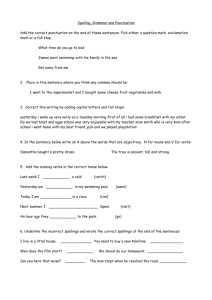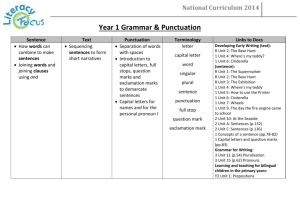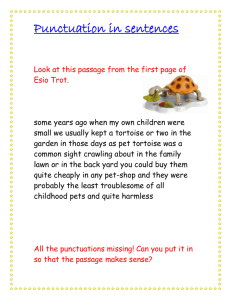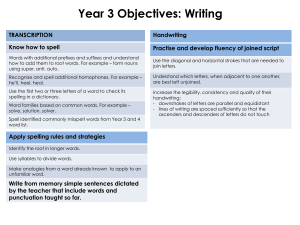Writing - acsliteracy
advertisement
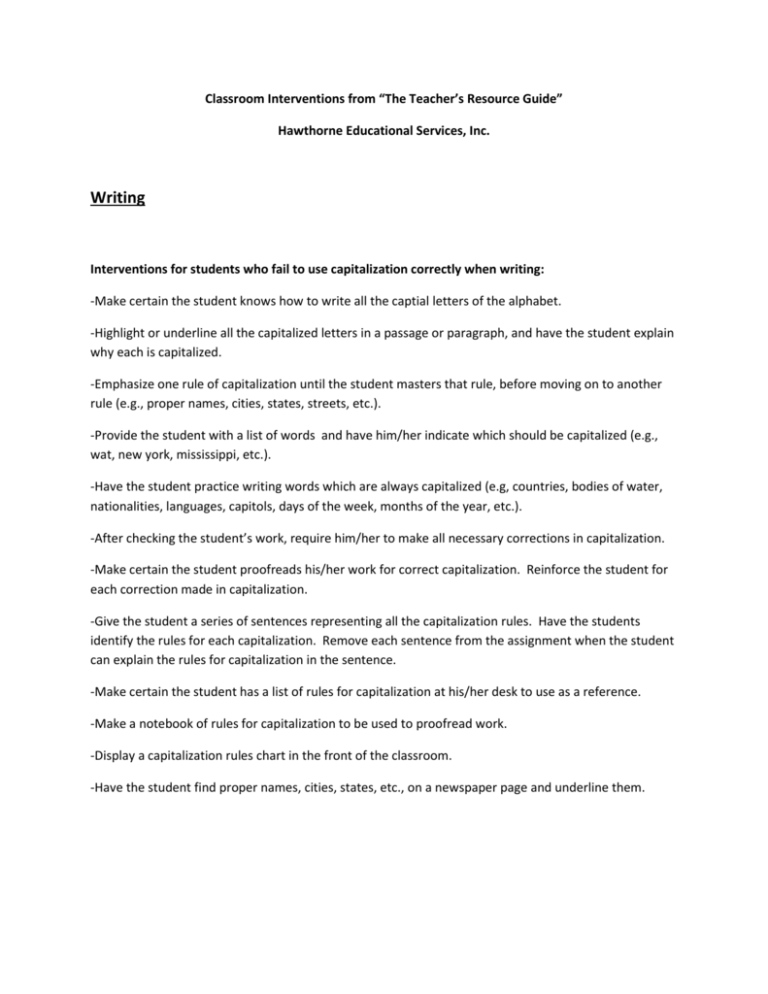
Classroom Interventions from “The Teacher’s Resource Guide” Hawthorne Educational Services, Inc. Writing Interventions for students who fail to use capitalization correctly when writing: -Make certain the student knows how to write all the captial letters of the alphabet. -Highlight or underline all the capitalized letters in a passage or paragraph, and have the student explain why each is capitalized. -Emphasize one rule of capitalization until the student masters that rule, before moving on to another rule (e.g., proper names, cities, states, streets, etc.). -Provide the student with a list of words and have him/her indicate which should be capitalized (e.g., wat, new york, mississippi, etc.). -Have the student practice writing words which are always capitalized (e.g, countries, bodies of water, nationalities, languages, capitols, days of the week, months of the year, etc.). -After checking the student’s work, require him/her to make all necessary corrections in capitalization. -Make certain the student proofreads his/her work for correct capitalization. Reinforce the student for each correction made in capitalization. -Give the student a series of sentences representing all the capitalization rules. Have the students identify the rules for each capitalization. Remove each sentence from the assignment when the student can explain the rules for capitalization in the sentence. -Make certain the student has a list of rules for capitalization at his/her desk to use as a reference. -Make a notebook of rules for capitalization to be used to proofread work. -Display a capitalization rules chart in the front of the classroom. -Have the student find proper names, cities, states, etc., on a newspaper page and underline them. Interventions for students who use inappropriate spacing between words or sentences when writing: -Have the student sit in an appropriate –sized chair with feet touching the floor, back pressed against the back of the chair, shoulders slightly inclined, and arms resting on the desk with elbows just off the lower edge. -Check the student’s paper position. A right-handed person writing in cursive should tilt the paper to the left so the lower left-hand corner points toward the mid-section; and as writing progresses the paper should shift, not the writing arm. -Make certain the student is shifting his/her paper when writing. -Using appropriate spacing, print or write words or sentences. Have the student trace what was written. -Provide the student with samples of handwritten words and sentences which he/she can use as a reference for correct spacing. -Have the student leave a finger space between each word he/she writes and dots between letters. -Draw vertical lines for the student to use to space letters and words (e.g., I I I I). -Teach the student to always look at the next word to determine if there is enough space to the margin. -Provide the student with graph paper, instructing him/her to write letters in each block,while skipping a block between words and sentences. -Have the student look at correctly written material to serve as a model. -Have the student perform a “practice page” before turning in the actual assignment. Interventions for students who fail to punctuate correctly when writing: -Give the student sentences to complete requiring specific punctuation he/she is learning to use (e.g., periods, commas, question marks, etc.). -Have the student practice using one form of punctuation at a time before going on to another (e.g., period, question mark, etc.). -Highlight or underline punctuation in passages from the student’s reading assignment. Have the student explain why each form of punctuation is used. -Have the student keep a list of basic rules of punctuation at his/her desk to use as a reference when writing (e.g., use a period at the end of a sentence, etc.). -Make certain the student knows what all punctuation marks look like and their uses. -Give the student a series of sentences representing all the punctuation rules. Have the student identify the rules for each punctuation. Remove a sentence from the assignment when the student can explain the rules for punctuation in the sentence. -Make certain the student has mastery of punctuation at each level before introducing a new skill level. -Give the student a set of 3 cards: one with a period, one with a question mark, and one with an exclamation point. As you read a sentence to the student have him/her hold up the appropriate punctuation card. -Give the student a list of sentences in which the punctuation has been omitted. Have the student supply the correct punctuation with colored pencils. -Make a notebook of punctuation rules to be used when the student proofreads work. -Use a newspaper to locate different types of punctuation. Have the student circle periods in red, commas in blue, etc. Interventions for students who reverse letters and numbers when writing: -Provide the student with visual cues to aid in making letters and numbers (e.g, arrows indicating strokes). -Provide the student with large letters and numbers to trace which he/she typically reverses. -Given letters and numbers on separate cards, have the student match the letters and numbers that are the same. -Have the student keep a card with the word bed at his/her desk to help in remembering the correct form of b and d in a word he/she knows. -Have the student keep a list of the most commonly used words which contain letters he/she reverses. This list can be used as a reference when the student is writing. -After identifying those letters and numbers the student reverses, have him/her highlight or underline those letters and numbers found in a magazine, newspaper, etc. -Make certain the student has a number line and alphabet strip on his/her desk to use as a reference to make the correct form of letters and numbers. Intervention for students who fail to form letters correctly when printing or writing: -Use color cues for lines (e.g., red for the top line, yellow for the middle line, green for the bottom line) to indicate where letters are to be made. -Highlight the base line or top line on the paper in order to help the student stay within the given space. -Identify those letters the student does not form correctly. Have him/her practice the correct form of one or more of the letters each day. -Check the student’s pencil grasp. The pencil should be held between the thumb and the first two fingers, one inch from its tip, with the top pointing toward the right shoulder (if right-handed). -Have the student practice tracing with reduced cues. Write the complete letter and have the student trace it. Gradually provide less of the letter for the student to trace (e.g., dashes, then dots) as he/she is successful. -To facilitate appropriate holding of a pencil, put colored tape on parts of the pencil to correspond to finger positions. Then put colored tape on the student’s fingernails and have the student match the colors. -Make certain the student has an alphabet strip attached to his/her desk in either printed or written form to serve as a model for the correct form of letters. Interventions for students who omit, add or substitute words when writing: -Have the student proofread all written work for omissions, additions, or substitutions. Reinforce the student for correcting omissions, additions or substitutions. -Encourage the student to read all written work aloud in order to detect omissions, additions, or substitutions. -Give the student several sentences and have him/her combine them to practice making a complete sentence (e.g., The car is new. The car is red. The car is mine. becomes The new, red car is mine.). -Give the student a list of transition words (e.g., therefore, although, because, etc.) and have him/her make sentences using each word. -Have the student write a daily log or diary expressing thoughts in complete sentences. -Have the student complete “fill-in-the-blank” stories and sentences and then read them aloud. -Have the student assist in grading or proofreading other students’ written work in order to become more aware of omissions, additions, and substitutions. -Give the student scrambled words from a sentence and have him/her put them in the correct order to form the sentence. -Give the student a group of related words (e.g., baseball, fans, gloves, strikeout, etc.) and have him/her make up a paragraph including each word. Interventions for students who do not use appropriate subject-verb agreement when writing: -Give the student specific verb forms and have him/her supply appropriate subjects to go with each (e.g., ________ runs.). -Have the student make up sentences with given verbs and subjects. -Give the student a series of sentences with both incorrect and correct usage of verbs and ask the student to identify which are correct and which are incorrect. -Have the student find examples of correct subject-verb agreement in his/her favorite books or magazines. -Show the student pictures of people, places, or things. Ask him/her to make a statement about each picture. Have the student identify the subject and verb of the oral sentence and tell whether or not they agree. -Give the student a series of sentences, both written and oral, and have him/her identify which are grammatically correct and incorrect. Interventions for students who do not compose complete sentences or express complete thoughts when writing: -Give the student a series of written phrases and have him/her indicate which ones express complete thoughts. -Have the student correct a series of phrases by making each a complete sentence. -After reading his/her written work, have the student explain why specific sentences do no express complete thoughts. -Make groups of cards containing subjects, verbs, adjectives, etc. Have the student combine the cards in various ways to construct complete sentences. -Have the student write letters to friends, relatives, etc., in order to practice writing complete sentences and thoughts. -Play a game by providing students with a box labeled “Trash.” Provide sentence strips with complete and incomplete sentences. Instruct students to “trash” incomplete sentences. -Provide exercises for making sentences out o f nonsentence groups of words. -Identify the qualities a good writer possesses (e.g., writing in complete sentences or thoughts, using correct vocabulary, etc.), and have the student evaluate himself/herself on each characteristic. Set a goal for improvement in one or two areas at a time. Interventions for students who fail to correctly organize writing activities: -Give the student a group of related words (e.g., author, read, love, bestseller, etc.) and have him/her make up an appropriately organized paragraph including each word. -Using a written essay that the student has not seen, cut the paragraphs apart and ask him/her to reconstruct the essay by putting the paragraphs in an appropriate order. -On a piece of paper, write five or six sentences about a story the student has read. Have the student cut the sentences apart and paste them together in the proper order. -Have the student write a paragraph describing the events of a daily comic strip such as Peanuts.

